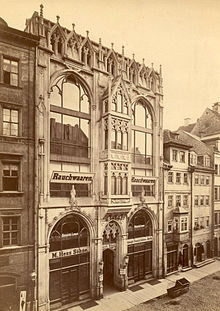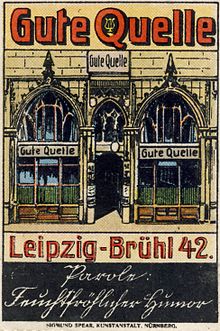Crime table
The criminal table of Leipzig had been a gathering of part of the city's intellectual elite, who were more democratic and progressive, from the mid-19th century. These were survivors of the revolution of 1848 who felt committed to the spirit of Robert Blum . The meetings took place in the cellar “Zur Guten Quelle” at Brühl , the building is no longer preserved. As a meeting place, the criminal table was also of importance for the beginning German labor movement .
Criminal table in Leipzig
Only people who met the following criteria were allowed to sit at the criminal table:
"The illustrious society in the" Guten Quelle "was divided into" sedentary "members, they had" sat ", into" admitted ", they belonged to their political convictions, but had no prison sentences behind them, and into guests, occasional participants of meetings or "sedentary". Anyone who at this strange Stammtischrunde wanted to participate, had a solemn admission process to endure, no matter to what state he applied. "
It was therefore an honor to be able to sit down at this table.
The table is adorned with the following inscription framed by an oak leaf wreath: “All faithful remembrance of all those who strive with us, death cannot offend anyone who has lived. 1856 ". This is probably the year of its inauguration.
On the table top, both in the oak leaves and on the edge of the table, the names of those who sat at it can be read.
Among them were scholars like u. a. the naturalists Emil Adolf Roßmaessler and Alfred Brehm , storytellers and writers like August Peters and Hermann Marggraff . Würkert often appeared as a democratic lecturer. Even Theodor Apel and Ernst Keil , the publisher of the gazebo were represented at it. Bebel mentioned the criminal table in his autobiography. He wrote:
“Not in contrast, but rather in addition to the gatherings at the Hotel de Saxe, was the restoration of the Guten Quelle auf dem Brühl, a large cellar restaurant that had just been built at the time and was run by Grun Forty-eight. In one corner of that place was a large round table called the Criminals Table. This meant that only the venerable heads of democracy who had been sentenced to prison or prison or who had been reprimanded were allowed to sit here. Both were more common. There sat Rossmessler, Dolge, who had been sentenced to death for his participation in the May uprising, was subsequently pardoned to life imprisonment and had then sat in Waldheim for eight years. The "criminals" also included Dr. Albrecht , who taught shorthand in our association , Dr. Burckhardt , Dr. Peters, Friedrich Ölkers , Dr. Fritz Hofmann , called Gartenlaube-Hofmann, etc. We boys considered it a special honor if we were allowed to drink a glass of beer at this table in the company of the old people. [...] "
The Dr. Peters was none other than August Peters, the husband of the women's rights activist Louise Otto-Peters . The writer Fritz Reuter was among the foreign guests . According to Fellmann, the aforementioned [August] Dolge was the only one who was initially sentenced to death, later to life imprisonment, and who was finally given amnesty. He was thus the "highest ranking" at this table. In 1858 he founded a piano factory in Leipzig. His son Alfred Dolge went to the USA and founded a factory there. a. Soundboards for pianos were made. The American city of Dolgeville goes back to him. It is conceivable that Wilhelm Liebknecht was sitting at the table, but not certain, especially since even Walter Fellmann and Bebel do not mention him in this regard. In the Hotel de Saxe , as Bebel mentioned, there were u. a. Wilhelm and Karl Liebknecht represented.
The criminal table in Leipzig is located in the City History Museum . It has been on display since December 11, 2011 in the Museum's Modern Times section . Bernd-Lutz Lange describes it in his book Life is a somersault .
Criminal table in Berlin
In Berlin there had been a circle around the writer Otto Erich Hartleben since 1896, which also called itself the criminal table. Rudolf Steiner , Otto Julius Bierbaum and Paul Scheerbart belonged to the regular cast, which represented an anti-bourgeois attitude . Käthe Kollwitz , Else Lasker-Schüler , Stefan Zweig and Erich Mühsam met at the Nollendorf Casino meeting point . A memento like the Leipzig crime table in the city history museum there probably doesn't exist in Berlin.
literature
- Andreas W. Daum: Science popularization in the 19th century. Civil culture, scientific education and the German public 1848–1914 . Oldenbourg Wissenschaftsverlag, Munich 2002, ISBN 3-486-56551-6 , p. 494.
- Walter Fellmann : Criminal table . In: Ders .: Leipziger Pitaval . Military Publishing House of the GDR, Berlin 1982, pp. 104–110.
- James N. Retallack (Ed.): Saxony in German History. Culture, society, politics 1830-1930 . University of Michigan Press, Ann Arbor, Mich. 2000, ISBN 0-472-11104-3 , p. 163.
- Rolf Parr: Die Verbrecher / Der Verbrechertisch [Berlin] , In: Handbuch literarischkultureller Vereine, Gruppen und Bund 1825 - 1933: (Repertories for German Literature History, 18), ed. by Rolf Parr, Wulf Wülfing and Karin Bruns, Stuttgart-Weimar 1998, pp. 456–459. ISBN 3-476-01336-7 , pp. 456-459.
Web links
- Leipziger Internet-Zeitung: Time travel on Tuesday: A regulars table celebrates the tenth. dated November 21, 2006
- Leipziger Internet-Zeitung: Time travel on Tuesday: The forest lawyer at the criminal table. dated February 28, 2006
- A. Bebel: From my life.
- Living time p. 9 (PDF file; 3.62 MB)
- Friedrichshagener poet circle
- Criminal table in Helmut Zander: "Anthroposophy in Germany: Theosophical Weltanschauung And ...", Volume 1
- Criminal table in the Leipzig City History Museum: 1850-1870 The beginning of the industrial age
Individual evidence
- ↑ Fellmann p. 105
- ↑ Fellmann p. 110
-
↑ Some of the names on the record can be found at http://museum.zib.de/sgml_internet/sgml.php?seite=5&fld_0=v0001570 In
addition to these, the engraving by R. Wolff reads: Roßäßler, Bock, August Keil , Benseler, Grumbach, Würkert, Hofmann, Moritz Dolge, Alfred Dolge, Grun, Oelkers, Albrecht. An enlargement of this engraving can be found in the City History Museum directly at the criminal table.
At Prim Berland: Hermann Marggraff. A German literary life. After his works and the letters he left behind, as well as contemporary journalism. Paris: Flory, 1942, p. 262, the names or their position at the table are as follows: "On the leaves of the oak wreath, the names of the leaders sentenced to prison terms in Leipzig are carved, namely: Aug. and MC Dolge, Aug. Peters, Dr. Th.Apel, Dr. Benseler , G. Schiebler, City Councilor Rau, Ferd.Vieweg, Carl Schmidt, Dr. Ed.Rau, CC Kering, C. Grumbach, CG Fischer, D. Sonntag, Dr. Th. Oetters, T. Wartenburg, Dr. Beyner, Dr. Marggraff , Dr. Ed.Burckhardt , A. Rossmässler, Dr. Fritz Hofmann , Dr. Sengnitz, Fritz Reiffarth. --- In the final loop there is the inscription: To his dear regulars A. On the edge of the table are the names of the gentlemen who initiated the foundation at the time and who were among the regular guests. They are: Aug. Grun, Rössler-Mühlfeld, Dr. GL Lindner, Jul. Kabitzsch, CH Reichert, CA Peters, Aug. Brasch, Dr. E. Müller, F. Grothe, Gust. Müller, CJ Knoteck, CH Ebert, E. Krah, WO Bahndorf, Edm. Kraft, Fritz Manec ke, W. Loewenberg, JF Uhlich, A. Seltmann, FJ Crusius, Fritz Schubert, GW Fischer, R. Naumann. " - ↑ Bernd-Lutz Lange: Life is a somersault: From the cheerfulness of being , Aufbau Verlag Berlin 2012, ISBN 978-3-351-02737-7 , pp. 69-72 (digital)



